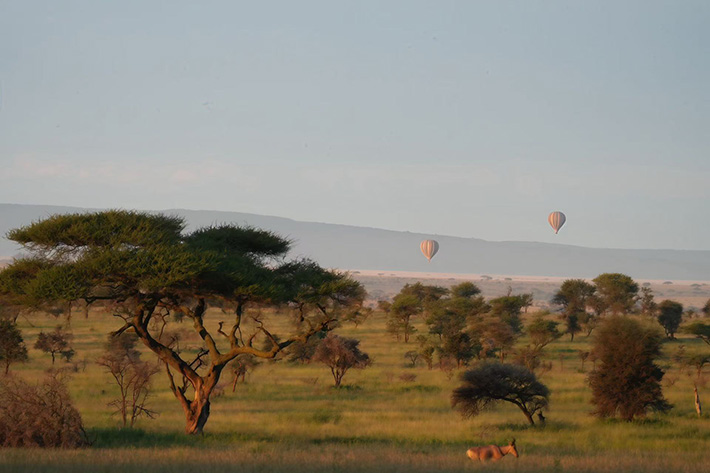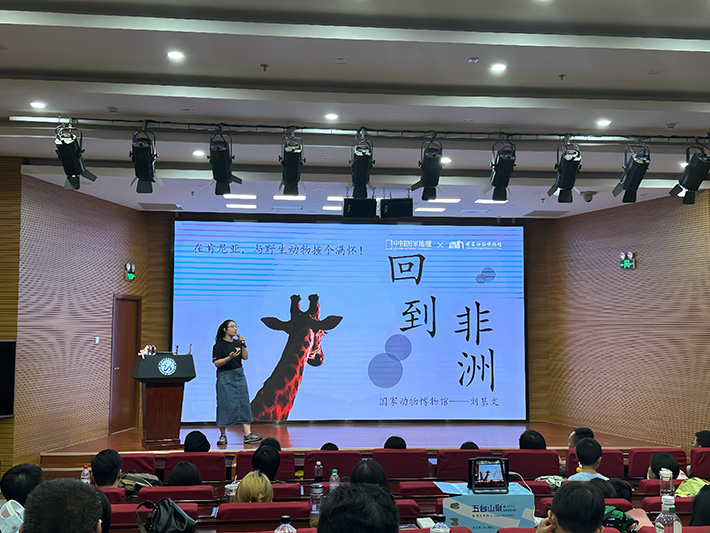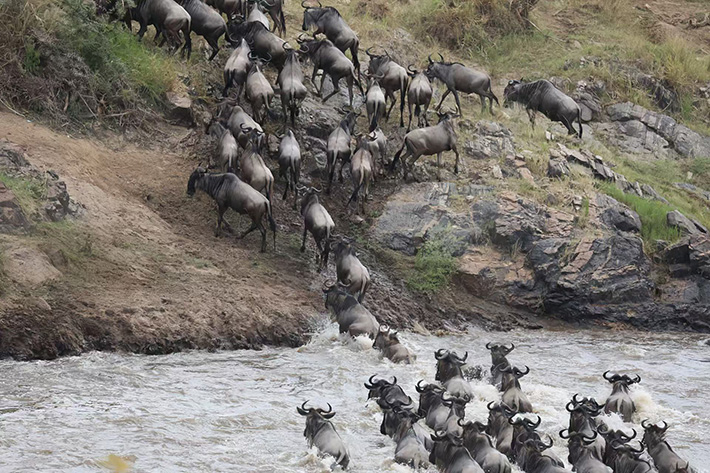|
||||||||||
| Home Top News Economy/Tech Culture/Sports China in Foreign Eyes Green Development Videos Intangible Cultural Heritages |
|
||||||||||
| Home Top News Economy/Tech Culture/Sports China in Foreign Eyes Green Development Videos Intangible Cultural Heritages |
| ChinAfrica |
| Symphony of Life |
| A young Chinese scientist’s in-depth exploration of Africa’s iconic wildlife |
| By Cao Naiyu | VOL. 17 October 2025 ·2025-10-10 |

Acacia trees on the African savannah (LIU JIWEN)
As 1.5 million wildebeest pierce the dawn mist of the East African Rift Valley and the roar of lions merges with the cry of zebras beneath sprawling acacia trees, this land unveils life at its rawest - majestic and achingly fragile.
From July to September, the East African Great Migration sweeps across the savannah with astonishing regularity. Millions of wildebeest, zebras, and other grazers form a vast, thundering procession as they travel from Tanzania’s Serengeti National Park to Kenya’s Maasai Mara National Reserve in search of water and fresh pasture. This spectacle of survival has continued for more than a million years.
For Liu Jiwen, a key member of the science communication team at China’s National Zoological Museum, such scenes are much more than fleeting impressions. As a young researcher with the Chinese Academy of Sciences, she has ventured deep into Africa six times to conduct field studies, immersing herself in the rhythms of the wild.
From tracking elephant herds across the Serengeti to documenting the territorial behaviour of hippos at dusk, her camera has captured the rhythms of the savannah. The dew-laced data she has collected provides precious material for African animal behavioural studies, while also serving as a bridge for collaborative ecological research between China and Africa.
Science and storytelling
Liu describes her work as “standing on the shoulders of those who came before.” Recently, she delivered a lecture titled Back to Africa as part of the “Tso-hsin Lecture Series,” where she vividly conveyed her first-hand experience of the migration to a public audience.
The lecture series itself has profound academic and historical significance. Named after the renowned Chinese ornithologist Cheng Tso-hsin, it honours his legacy. In 1930, Cheng gave up a promising career abroad and returned to China. After nearly two decades of dedicated research, he published Checklist of Chinese Birds in 1947, breaking the Western monopoly on ornithological scholarship and laying the foundation for modern ornithology in China.
He later wrote popular science works such as Flying With Birds, inspiring generations of young people with both a spirit of exploration and a sense of national commitment. More than half a century on, this tradition of integrating research and public engagement continues to shine through in the work of new scholars such as Liu.
In her lecture, Liu brought the science of the savannah to life through vivid, relatable examples. She explained how lions cooperate in hunting, revealing the delicate balance within the food chain. She recounted how the Maasai people use traditional knowledge to track rhino migration routes, showcasing ancient wisdom and a way of life in harmony with nature. These cross-species, cross-border stories became powerful teaching tools, reinforcing the idea that “science knows no boundaries, and ecology calls for shared empathy.”

Liu Jiwen delivering her Back to Africa lecture (CAO NAIYU)
An epic of survival
The East African Great Migration is nothing less than an epic of life. Each year, more than 1 million wildebeests, zebras, and gazelles embark on a journey of nearly 3,000 km. In addition to ambushes by lions and leopards, they must also brave the crocodile-infested Mara River. Because of the extreme danger, the crossing is poetically described as “the crossing to paradise.”
The herd’s northward march in search of food and water lasts until October, when they begin their return south to the Serengeti. This journey across Tanzania and Kenya comes with an individual mortality rate of about 30 percent. Yet within the dangers lies a remarkable display of ecological cooperation. Zebras eat the tall grass, exposing tender shoots. Wildebeest feed on the middle layer. Gazelles follow behind, grazing the fresh sprouts. Together they form a moving “ecological harvester.”
To Liu, the wildlife in the region forms a system of deep interdependence. “Wildebeests are often called the granary of Africa,” she said, highlighting their crucial role in sustaining carnivores. “Their presence exerts a strong influence on other species, for instance by competing with antelopes for grazing resources.”
The migration routes themselves function as nature’s lifelines. The Serengeti’s rainy-season grasslands and the Maasai Mara’s dry-season oases act as natural supply stations. Dust stirred by the moving herds even becomes a nucleus for cloud formation, helping to regulate local rainfall. This interlinked chain of life exemplifies a cycle where the savannah nurtures its creatures, and in turn is shaped by them.

Wildebeest crossing a river during the Great Migration (LIU JIWEN)
Guardianship across continents
Over the past decade, China and Africa have stepped up ecological cooperation. In May 2013, the Chinese Academy of Sciences approved the creation of the Sino-Africa Joint Research Centre, the first comprehensive science and education institution China has built abroad in a developing country. For more than a decade, it has worked to protect biodiversity and support sustainable use of biological resources.
The core principle of this cooperation is shared guardianship. The framework extends from infrastructure to community development, embedding protection at every stage. In major projects, Chinese approaches emphasise “ecology first.”
Liu cites the example of the Mombasa-Nairobi Standard Gauge Railway. Designed according to Chinese standards, it carefully incorporated measures to protect the savannah and migration routes. Noise reduction and wildlife corridors were part of the blueprint, offering a model for aligning infrastructure with ecological conservation.
From handicraft cooperatives to wildlife observation stations, each new source of green income cultivates a deeper appreciation for nature.
At the close of her lecture, Liu reflected: “In truth, none of us owns Earth. We are simply fortunate to coexist with all living beings. The value of China-Africa cooperation lies here - it reminds us that visits to Africa are not about escaping urban life, but about remembering the fundamental fact that we belong to nature.”
In the golden light of the savannah, beneath the silhouettes of acacia trees, her words resonate with the deeper meaning of the migration. It is not only a journey of survival for wildebeest and zebras, but also a call for humanity to recognise its place within the eternal cycle of life.
|
||||||||
| About Us | Contact Us | Advertise with Us | Subscribe |
| Copyright Beijing Review All rights reserved 京ICP备08005356号-5 京公网安备110102005860号 |